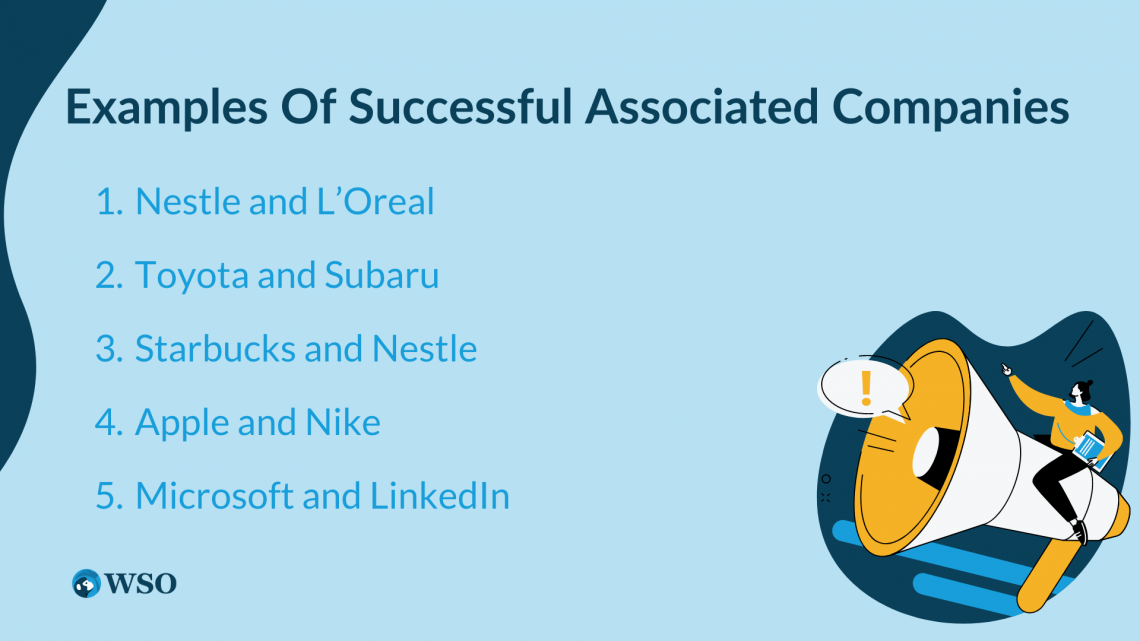Associate Company
It offer various advantages to businesses in contemporary business strategies
What Is An Associate Company?
An associate company is a corporation where a parent company holds an ownership stake but typically only a minority or noncontrolling interest.

The definition of an associate company can vary depending on the jurisdiction and field of study, such as economics, accounting, taxation, and securities.
Associate company relationships often occur through joint ventures, where two or more companies collaborate, each holding a partial ownership stake.
When a company invests in an associate company, it reports the investment on its consolidated financial statements. Unlike with subsidiaries, the parent company does not usually consolidate the financial statements of the associate company.
Instead, the parent company records the value of the associate company as an asset on its balance sheet.
Consolidated financial statements combine the financial information of the parent company along with information from its associate company and its subsidiaries.

While there is typically no mandatory consolidation of an associate company's activities, most countries' tax rules must be considered when preparing financial statements and tax returns.
Investors and regulators do not like the intricate structure of these companies due to concerns about these businesses' transparency and financial integrity.
The complex corporate structure can allow the parent company to manipulate funds or engage in money laundering through investments or loans to these companies.
Furthermore, some parent companies acquire stakes in foreign associate companies to take advantage of tax benefits and evade significant tax obligations.
In some situations, the parent company may need to give an unbiased and accurate representation of their associate company's financial position, resulting in a misrepresentation of the overall financials of the entire group.

In such companies, generally, the parent company owns between 20% and 50% of the shares of the associate company. It has some influence over its business decisions, but not enough to make it a subsidiary.
Associate companies are often formed through joint ventures, where two or more companies collaborate on a project or business plan.
Such companies can be used for strategic purposes, such as gaining access to new markets or acquiring new technologies.
For example, Samsung and Spotify came into a strategic partnership in 2018, where Samsung integrated Spotify into its devices and services, such as smart TVs, smartphones, and smart speakers. Spotify became the default music service for Samsung's voice assistant, Bixby.
Key Takeaways
- Associate companies, also known as affiliated or subsidiary companies, offer various advantages to businesses in contemporary business strategies.
- Organizations can extend their market reach and enter new geographic regions or target different customer segments by forming strategic alliances and partnerships with an associate company.
- Business operations are diversified by engaging with such companies which are operating in diverse industries or sectors, reducing reliance on a single product or market.
- Access to novel technologies and resources is facilitated through strategic partnerships with associate companies specializing in research and development or possessing unique intellectual property.
- Associate companies drive overall growth through new market opportunities, diversified operations, access to resources, and driving innovation.
Benefits Of Associate Companies
Associate companies can help and provide significant advantages for businesses, with one of the key benefits being the ability to enter new markets.

The benefits are explained below:
1. Expansion
Businesses can expand their reach into different geographic regions or target specific customer segments through strategic partnerships or acquisitions.
This approach enables organizations to tap into existing networks, distribution channels, and customer bases, saving valuable time and resources that would otherwise be required to establish a presence independently.
Note
By leveraging the established market presence of their associate companies, businesses can quickly grow their customer base and enhance brand visibility.
2. Diversification
Another advantage of these companies is the opportunity to diversify business operations. Organizations can reduce their reliance on a single product or market by engaging with companies operating in different industries or sectors.
This diversification strategy enables companies to adapt to changing market conditions, economic cycles, and consumer preferences.
Collaborating with these companies provides access to new product lines or services, creating synergies that drive revenue growth and improve overall business performance.
Note
Strategic partnerships with them offer access to valuable resources and expertise.
3. Integration
Organizations can leverage their associate company's research and development capabilities, unique intellectual property, or specialized skills to stay at the forefront of innovation.
By integrating these resources and technologies into their business processes, companies can enhance their range of products, optimize operational efficiency, and attain a competitive advantage in the marketplace.
These companies can foster a culture of learning and innovation within the organization by providing access to talent pools and promoting collaboration.
Examples Of Successful Associated Companies
There are several instances of successful companies’ that have experienced substantial growth and prosperity by forming strategic partnerships and alliances.

Let's see some real-life successes of them.
1. Nestle and L’Oreal
In 1974 Nestle and L'Oreal started their strategic partnership, bringing together Nestle, a major player in the food industry, and L'Oreal, a renowned name in the cosmetics and beauty sector.
Through this collaboration, Nestle acquired a stake in L'Oreal, enabling both companies to benefit from each other's strengths and pooled resources.
The partnership proved highly fruitful, with L'Oreal leveraging Nestle's distribution channels and global reach while Nestle gained access to the thriving beauty and skincare industry.
2. Toyota and Subaru
In 2005, Toyota and Subaru came together, merging the automotive expertise of Toyota, a renowned car manufacturer, with Subaru, a subsidiary of Fuji Heavy Industries.
Note
The primary focus of this collaboration was to concentrate on the design and manufacturing of sports cars.
The partnership achieved significant success by sharing resources, reducing costs, and combining their manufacturing and engineering prowess and garnered worldwide popularity for its exceptional sports cars.
Starbucks and Nestlé formed a strategic alliance in 2018. Nestlé acquired the rights to market, sell, and distribute Starbucks' packaged coffee and tea products globally.
This collaboration allowed Starbucks to expand its retail presence and reach a wider consumer base through Nestlé's extensive distribution network. Simultaneously, Nestlé strengthened its position in the premium coffee market.
Note
The partnership proved mutually beneficial and facilitated the growth of both companies in their respective domains.
4. Apple and Nike
In 2006, Apple and Nike collaborated on the Nike+ iPod Sport Kit, an innovative product that merged Nike's sports technology with Apple's iPod.
This partnership enabled users to track their fitness activities and synchronize the data with their devices. Leveraging Apple's technological expertise and Nike's renowned brand presence in the sports industry, the collaboration proved highly successful.
Note
Subsequent products, like the Nike+ Apple Watch, were introduced due to this partnership.
5. Microsoft and LinkedIn
Microsoft made a landmark acquisition in 2016 by purchasing LinkedIn, a professional networking platform, for over $26 billion.
This acquisition allowed Microsoft to tap into LinkedIn's extensive user base and professional network, integrating it with its productivity tools and services suite.
By leveraging LinkedIn's data and insights, Microsoft enhanced its business solutions and expanded its presence in the professional networking sphere.
The acquisition has proven significant success, driving revenue growth and strengthening Microsoft's position in this domain.
Note
Associate companies are often used for tax purposes, as they can reduce the taxable income of the parent company by sharing losses or expenses.
They can also avoid double taxation by using the equity method of accounting, where the parent company only reports its share of the associate company’s profits or losses.
These examples exemplify the potential for success that associate companies can achieve through strategic partnerships, alliances, and acquisitions.
Summary
In accounting and business valuation, an associate company refers to a company in which another company holds a significant portion of voting shares, typically ranging from 20% to 50%.

When a company owns an associate company, it does not consolidate the associate company's financial statements.
The value of these companies is recorded as an asset on the balance sheet. The investor's share of the associate's income is reported in the income statement, reflecting the proportional ownership.
Dividends received from the associate reduce the value of the investment on the balance sheet. In Europe, investments in associate companies are referred to as fixed financial assets.
The article has listed many examples of associate companies and their abilities and why companies adopt such strategies.
Companies need to look for such strategies sometimes to overcome problems or just to optimize their business position in the market.
Researched and authored by Neeraj Pandey | Linkedin
Free Resources
To continue learning and advancing your career, check out these additional helpful WSO resources:









or Want to Sign up with your social account?